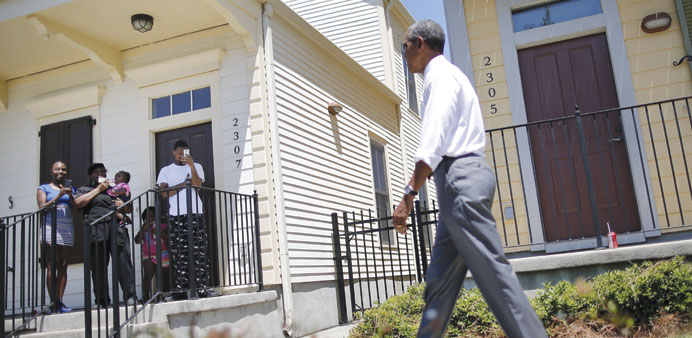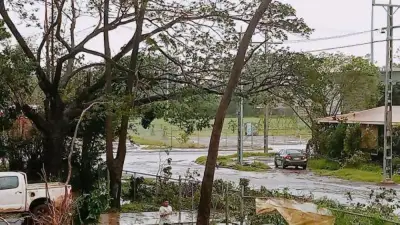Local residents take pictures during Obama’s visit to an area reconstructed after Hurricane Katrina, in New Orleans, on Thursday.
AFP/New Orleans
President Barack Obama paid tribute to New Orleans and its people after seeing first-hand on Thursday how far the “Big Easy” has come, 10 years after Hurricane Katrina laid waste to swathes of one of America’s most famous cities.
“You inspire me,” Obama told a community centre to applause, after rolling up his sleeves on a stroll through the historic African-American community of Treme, stopping to chat with residents for whom Katrina remains etched in memory.
“This city is moving in the right direction and I have never been more confident that together we will get to where we need to go,” Obama said before the crowd of 600 people at the community centre in the Lower Ninth Ward, one of the poorest and worst storm-hit areas of the city.
“New Orleans is coming back better and stronger,” he added, evoking “a city that for almost 300 years has been the gateway to America’s soul”.
“Where the jazz makes you cry, the funerals make you dance, the bayou makes you believe all kinds of things, a place that has always brought together people of all races and religions and languages, and everybody adds their culture and flavour into the city’s gumbo.
“You remind our nation that for all of our differences, we’re all in the same boat.”
Katrina destroyed levees and submerged 80% of New Orleans in effluent-tainted storm water, but it was the government response which still rankles many, even a decade later.
Americans watched shocked as stranded survivors waited day after day on rooftops for government help that was painfully slow to come, shattering confidence in their government.
Obama contrasted that troubled initial response under his predecessor George W Bush with more successful efforts to resurrect New Orleans: An allegory of what happens when government gets it wrong, and what happens when government gets it right.
Despite the unmistakably upbeat message there is no doubt that plenty of work still remains in New Orleans – Obama admitted as much – where more than 1,800 people were killed and 1mn more displaced when Katrina barrelled in from the Gulf of Mexico.
The president greeted residents among the new pastel paint and wood-shuttered windows in Treme, crediting partnerships between local, state and federal government for the resurrection of the historic neighbourhood.
“Like so much of this area it was devastated during the storm,” Obama said, as he took in a revitalised Magic Street. “Now just because the housing is nice doesn’t mean our job is done.
“This is a community, obviously, that still has a lot of poverty ... but the fact that we can make this many strides 10 years after a terrible, epic disaster, I think is an indication of the kind of spirit that we have in this city.”
He then headed to lunch at Willie Mae’s Scotch House, famous for its fried chicken.
In the afternoon, Obama went to the Lower Ninth Ward, a gritty neighbourhood which Katrina made as synonymous with New Orleans as Dixieland jazz or Mardi Gras on Bourbon Street.
“Our work here won’t be done when almost 40% of children still live in poverty in this city,” he told the community centre. “That’s not a finished job. That’s not a full recovery. Our work won’t be done when a typical black household earns half of what a typical white household earns in this city. The work is not done yet.”
Obama’s trip was intended to mark the rebirth of a city eulogised by Tennessee Williams as the “last frontier of Bohemia”, but which in August 2005 became a nightmare of death and looting.
The storm surge scarred the city, but also forged a high watermark of criticism of Bush’s administration.
A photograph of a concerned but detached president Bush viewing the damage from Air Force One has become emblematic of the politics of the crisis.
But Obama risked looking similarly out of touch if he too strongly talked up New Orleans’ recovery, experts said.
That message “would resonate more with the city’s white residents than with its black residents”, said Michael Henderson, of Louisiana State University (LSU).
According to a recent LSU poll, the vast majority of white people in the city believe Louisiana has mostly recovered from the storm.
Three in five black residents, however, say it has not.



